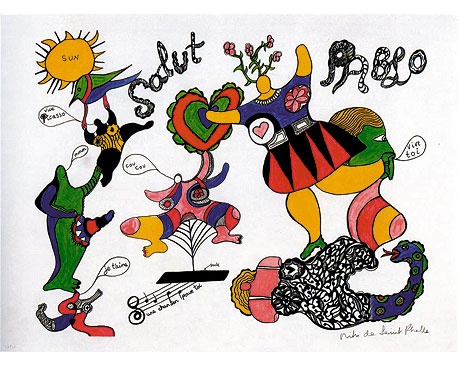Pablo Picasso. In Homage to Picasso ― from Miró to Lichtenstein

The exhibition comprised two sections:
Part 1 Picasso as a graphic artist
The first part of the exhibition showcased graphics and illustrations created by Picasso, providing visitors with the opportunity to become acquainted with the artist's immensely valuable graphic works produced between 1904 and 1920. An etching entitled Le Repas Frugal (1904) is especially noteworthy, as it was one of the works made at the close of the ‘Blue Period’, and is characterised by merciless realism of gaunt, slender figures, who create a sombre, melancholic feeling. The graphics which belong to the Les Saltimbanques cycle evoke a radically different mood. They belong stylistically to the so-called ‘Rose Period’, and contain a big charge of positive emotions, featuring characteristic motifs and characters from circus life. Apart from the earlier examples of graphics, the display included Picasso's achievements as an illustrator and stage designer, divided up into three sections. The first of these, chronologically, Le Tricorne (1920), featured graphic designs of costumes and theatre scenography for the play of the same title. The other two collections, La Celestine (1971) and Le Cocu Magnifique (1968), represented the artist's mature illustrative artwork. Importantly, the presented graphics included the lino-cuts which Picasso had created in Vallauris, in collaboration with the publisher Arner.
Part 2 In Homage to Picasso — from Miró to Lichtenstein
The second part of the exhibition featured works by 69 artists ranking amongst the 20th century classics. “Hommage a Picasso” was an unusual collection of graphics dedicated to Pablo Picasso initiated by Wieland Schmied — a German critic, publisher, and populariser of art. The call for prints was made following the news of Picasso's death. What made this collection unusual and precious was the involvement of many eminent artists combined with the diversity of concepts and trends which they represent. The contributors included the surrealist Joan Miró, pop-art artists: Andy Warhol, Claes Oldenburg, Roy Lichtenstein, Richard Hamilton, Eduardo Paolozzi, as well as representatives of ‘new realism’, such as Christo, Joseph Beuys and Roberto Matta.

Pablo Ruiz Picasso (1881-1973)
Considered to be one of the most influential artists of the 20th century, Picasso remains the symbol of modernity, innovation and infinite creative inspiration. His talent and creative power knew no bounds. Picasso did not limit himself to painting as the only means of artistic expression and unhesitatingly produced other kinds of artistic output: ceramics, sculpture, graphics, illustrations for literary works, stage designs, collages, and even writing.
The work of this Spanish French or, perhaps more fittingly, French Spanish, artist (Picasso was born in Malaga in southern Spain, but spent his whole adult life in France), went through different artistic styles and trends, including cubism, classicism, realism, surrealism and abstraction. The artist embraced a variety of techniques, endowing some of them, for example ceramics and assemblage, with a new potency and meaning. Over and over again, the employment of new techniques turned him into a master of illusion, who amazed the craftspeople, for example, ceramists and graphic designers, who worked with him, with the courageous and versatile manner of handling the materials. According to Frank Elgar, Picasso, despite his extraordinary skill, never considered technical capability to be a value on its own. Technique never overshadowed his natural inquisitive flair, and courage rarely gave way to virtuosity.
The exhibition “Pablo Picasso. In Homage to Picasso — from Miró to Lichtenstein”, presented Pablo Picasso's prolific graphic output in the form of 132 prints, including some of his early works dating from 1904-1920. These graphic cycles were displayed alongside works produced in homage to Pablo Picasso by 69 artists, who represented various 20th century movements, including pop-art, surrealism, op art and minimal art.




